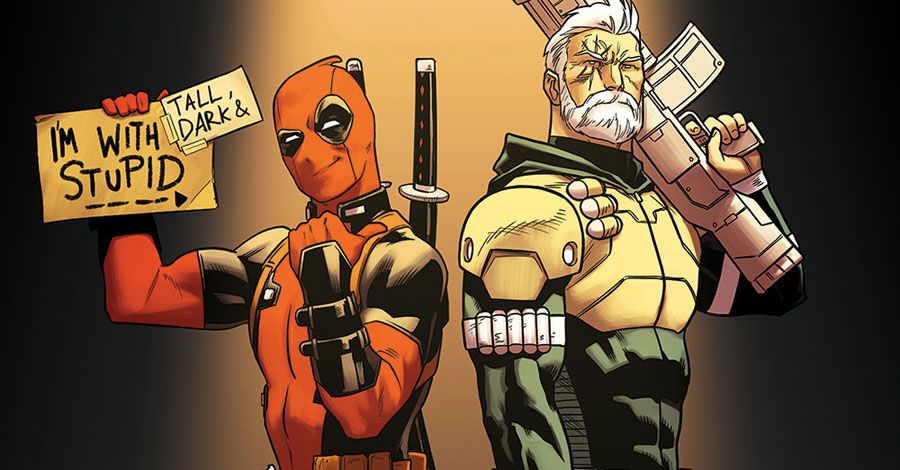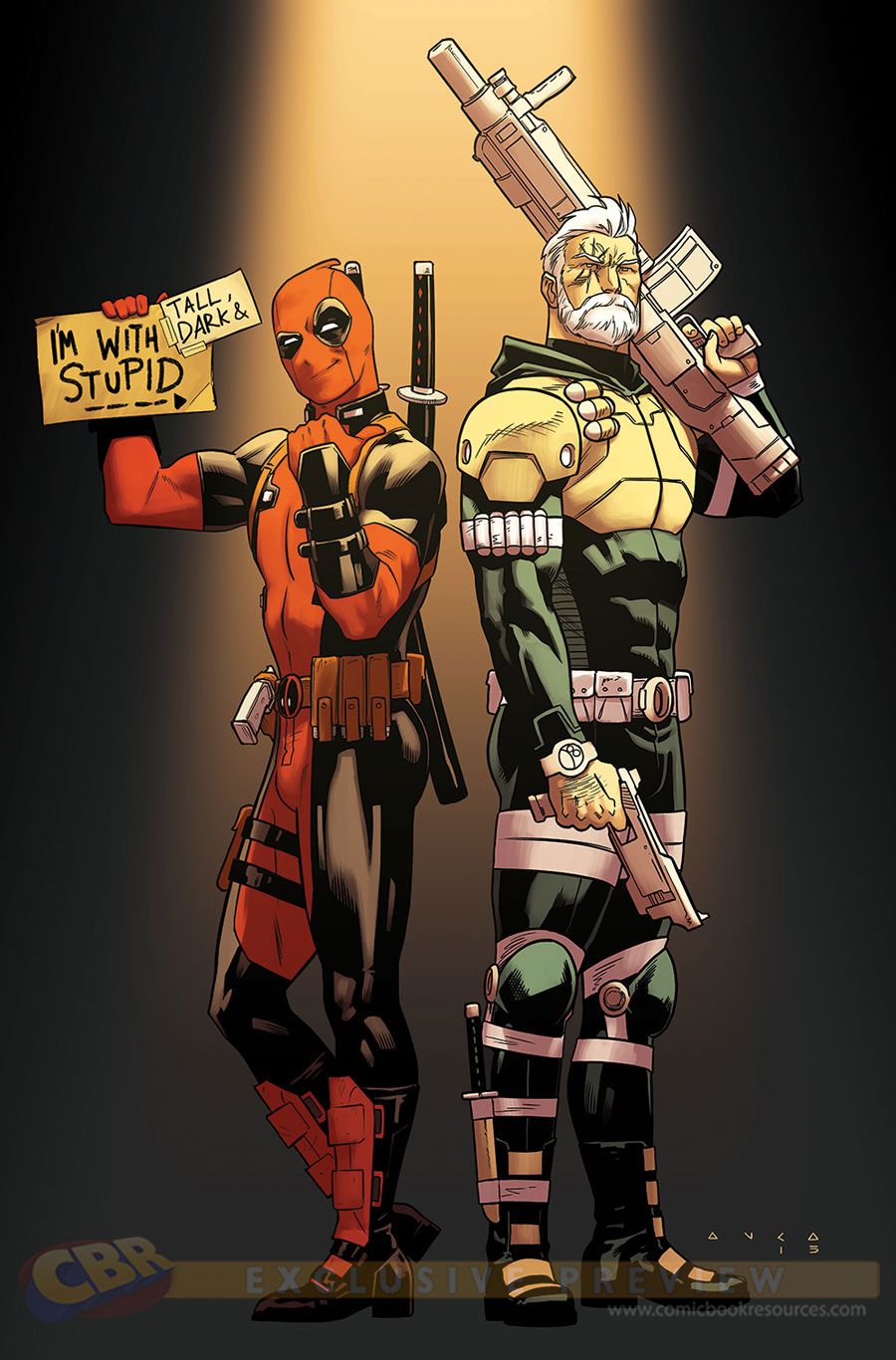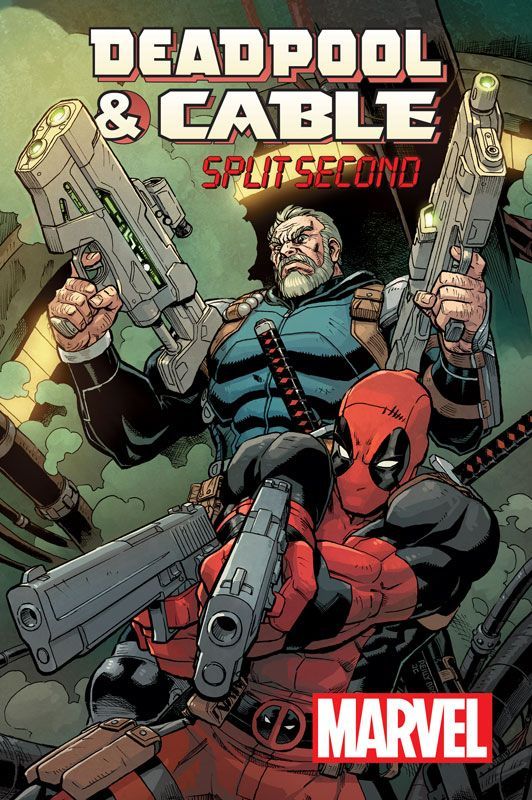Between his upcoming solo series relaunch, joining the Avengers and headlining his own feature film, Deadpool is riding a killer wave of popularity these days, so it may be hard to believe there was a time when Deadpool wasn't the headliner of his own book. In the early 2000s, he was popular, sure, but Wade Wilson had to co-headline a series with another heavily-armed X-Men character -- the time traveling mutant soldier from the future known as Cable.
"Cable & Deadpool" ran from 2004-2008 and lasted 50 issues, all of them written by Deadpool's co-creator Fabian Nicieza. Over those four years, it remained a fan favorite series because of the way it weaved together buddy action-comedy stories with the science fiction of the Marvel Universe. Over the course of the book's run, Nicieza worked with a number of artists, but one of his longest and most fruitful collaborations was with Reilly Brown. Brown illustrated the book for several years, and in the waning days of the series, the duo co-wrote the last few issues together.
RELATED: Deadpool Co-Creator Weighs in on Character's Sexuality
Since the wrap of their series, Deadpool and Cable have not had much interaction with each other, having ended up in very different places, physically, mentally and even emotionally. But this October, they reunite -- along with Nicieza and Brown -- for a new miniseries titled "Deadpool & Cable: Split Second," which will debut first as a six-part digital Infinite Comic series before being released in print in December.
CBR News: Now, you collaborated for several years on "Cable & Deadpool," and you even co-wrote the last few issues of that series together. How does it feel to return to these characters and to be working together again?
Fabian Nicieza: I can't speak for Reilly, but for me it feels like slipping into a nice, comfortable pair of used underwear. I feel both support and warmth.
Reilly Brown: It's like a reccurring nightmare that I can't wake up from! Like a traumatic flashback that I just can't escape! It's like every time I think I'm out, they drag me back again! I wake up, and it's Deadpool. I go to sleep -- Deadpool! I drink to the bottom of the bottle I found sitting on the street corner, and it's just more crazy man with katanas staring back at me!
So in other words, it's pretty great! Besides, there's no better character to work with at Marvel than Fabian.The last time we worked together on "Cable & Deadpool," that was my first significant project at Marvel, fresh out of art school, and I learned a whole lot about the art of comics and storytelling. Fabian did a great job of showing me the ropes. In a lot of ways, it feels like coming full circle to be teamed up with him again, especially as we team Nate and Wade up again for the first time in a long time.
Since you've last worked on these characters, they've undergone a number of changes. Do you think that will impact their initial dynamic when they first encounter each other in "Split Second?" Do you think the way Nathan and Wade view each other has changed because of what's happened to them in recent years?
Nicieza: That all plays into the story quite significantly. They are in very different places right now. Not wanting to give a joke away, but Deadpool is on top now, Cable isn't in a great place.
Brown: They haven't spent much time together since Cable left the "Cable & Deadpool" book all those years ago, so they've definitely got some reconnecting to do. They've both gone through some pretty major life changes since then, and have entirely new status quos. In a weird way, between the two of them, Deadpool's the one who's got his act together -- married, on S.H.I.E.L.D. and the Avengers, reconnected with a daughter he didn't even know he had. Meanwhile, Cable's got nothing, not even his powers.
Nicieza: I think it's interesting to see a Deadpool who has less of an insecure need to impress Cable and get his approval, while it's interesting to see a significantly more weary and worn Cable.
Reilly, let's talk a little bit about the look of your protagonists. Who are these characters to you visually? And I noticed Cable is sporting a beard in the cover/teaser image for "Split Second." What inspired you to give him facial hair?
Brown: Visually, Deadpool is dynamic and light on his feet. Always in motion, jumping on or over things. Cable is large and heavy. He's built like a brick wall, and his feet are firmly planted on the ground, not going anywhere. Even though Deadpool has a full face mask, somehow his face always ends up the more expressive one out of the two of them.
I felt like Cable's facial hair situation was a good visual representation of where he is emotionally, right now. He's scruffier, and not his normal clean-cut self. When he first shows up, he has a jacket with the Askani military insignia on it. I was thinking of him as an old Vietnam War vet, not sure where he fits into the world. And of course, for a time displaced soldier like Cable, he doesn't have flashbacks, he has flashforwards.
Let's move to the events that bring Deadpool and Cable back into each other's orbits. What happens that sets your story in motion?
Nicieza: Cable's status quo after the recent "X-Force" series is that he lost the techno-organic virus, but with that, he also lost his telekinetic and telepathic powers.
He has been left with "precognitive flashes," but they aren't the most reliable of images. He has a pre-cog flash that Deadpool has shot a man in the middle of a Manhattan street, and tracks Deadpool down to warn him/stop him. But the odd thing is, Deadpool just saved this alleged murder victim from a Hydra kidnapping, so why would he want to kill him?
In typical Deadpool logic, he figures that should there be another attempt to kidnap him, the best way to avoid shooting Dr. Weathers is by only using his katana blades around him. As opposed to, say, moving to Tibet.
When an assassin does come to kill Weathers, hilarity and murder ensues.
The story description reads like a sci-fi buddy action comedy? Is that a fair description of what you're aiming for with this story?
Brown: Buddy action comedy, or perhaps buddy action tragedy. I suppose it depends which time line you live in.
Nicieza: I think the "Cable & Deadpool" book worked best when it was grounded as an "SF-Adventure Buddy Book," so that is the approach we're taking. I know Deadpool has a lot of supernatural elements in his status quo now, but I don't think they play as well when Cable is involved.
This will be the kind of good old-fashioned, ass-kicking, teeth-gnashing, Hydra-bashing, time-traveling escapade that works very well for the two characters when they're together!
Will we see family members like Wade's wife Shiklah, or Nathan's daughter Hope in the series? And is there a chance that this story will also mark your return to your fan-favorite creation -- Bob, Agent of Hydra?
Nicieza: We will see Preston, Bob and Shiklah in the story. I reach out to Gerry [Duggan, the writer of "Deadpool"] anytime I have a question about some of the more recent characters.
The other supporting character of note is Mark Gruenwald (sort of). Mark was secretly a presence throughout all of the "Cable & Deadpool" run, so it made a lot of sense to bring him out in a more prominent role for this story.
What can you tell us about the villain of "Split Second?" Are they a new creation, or an established Marvel character?
Brown: He's a brand new character. He fits in pretty well with our cast because, like Cable and Deadpool, the more he tries to fix things, the more he seems to break them.
Nicieza: All I will say is that he is an assassin from the near-future who has come to kill a man he claims will be the cause of a lot of death and destruction down the road.
Before it hits print, this will be released as a Marvel Infinite Comic. Reilly, you have experience working in this kind of format already, but Fabian, do you have experience writing for digital comics?
Brown: I've done a few Infinite Comics with Marvel, most notably "The Gauntlet" where we introduced Deadpool's wife, Shiklah. When I was working on "Power Play," this type of digital storytelling wasn't something that many people had done, and it's a lot of fun to be able to find ways to break new ground with the art form. To tell comics stories in ways that Jack Kirby hadn't already mastered before I was born. I feel like every digital comic I draw, I find some new technique, some new way of approaching a scene, that's never quite been done before. Every time, it just adds one more weapon to my storytelling arsenal with "Split Second," there's a time travel aspect that's really cool, and opens up some really interesting storytelling possibilities. If we can pull this off, I think it'll really blow people away.
Nicieza: Outside of comics, for the work I've done with Starlight Runner Entertainment over the last 15 years, I've worked on a lot of multi-platform projects that involved storytelling challenges for digital applications. I think the Infinite format is a new and unique way to tell a story, and I was really excited to work with Reilly on this, since he'd been chomping at the bit to do more of this kind of work when we were originally doing "CDP" together back in 2008/2009!
How are you guys writing this series together? Is it as simple as one of you scripts and the other plots? Or is it more involved?
Nicieza: Because I think the Infinite format is so visual in nature that you are, in essence, generating "low-level animation," I asked if Reilly could co-plot the series. So I outline what the chapter will contain in scene beats, some scenes more detailed than others.
Jordan [D. White] and Heather [Antos] provide notes, then Reilly does thumbnail layouts to approximate the "screen count." This includes how the screen swipes will dictate aspects of panel flow and "animation," breaks down the action flow, etc.
We all comment, then I do a rough first script pass. Reilly can tighten the pencils to that, seeing how the jokes land, the dialogue flows, and the emotional beats play out. Once approved, Jay is inking and I will do a second pass script to accommodate any necessary tweaks.
That's it from my end, but Reilly and the production team have a lot more work to do after that. I think it's significantly more work for everyone than a standard comic, but it's a really enjoyable experience and, I think, a great opportunity to expand the medium, in format, if not in content!
Brown: Doing a comic for the Infinite format can be a whole lot different than a regular print comic -- lots more layers, panels that repeat and change in weird ways. It takes some people a while to wrap their heads around it, but Jim Charalampidis, our colorist is able to keep up with all the crazy stupid things I'm doing. It's probably because of his animation background, since some of the image files have to be set up more like animation than a regular print comic. And also, yeah, doing a comic this way can be significantly different than a print comic, and sometimes that can be a whole lot more work than a print comic, especially because every time I come up with a crazy idea I think is cool, even when I know it will make my life harder--I can't resist!
Finally, if "Split Second" resonates with readers, would you both be up for doing more with Deadpool and Cable?
Brown: Definitely. I always have an awesome time drawing these characters, and I think they're the most fun when they're playing off each other.
Nicieza: You mean we haven't been working on the book continuously on a monthly basis since 2009? Really? That's weird, because we have been in my mind --I thought I had to deliver the plot for issue #132 by next week. I was wondering why I hadn't been seeing my comp copies for the last six years...
Brown: I'm psyched to get the band back together, and I'm glad that people have been responding so well to the Infinite Comics format that Marvel keeps letting me make more of them!



